Abstract
Owing to increasing rates of hypertension and cardiovascular-related diseases in developing countries, compliance with antihypertensive medication is major public health importance. Few studies have reported on compliance in developing countries. We determined the compliance of 187 patients with uncontrolled hypertension in the Seychelles (Indian Ocean), by assessing the presence of a biologic marker (riboflavin) in the urine. The urine tested positive in 56% of the cases. Compliance varied from one physician to another (highest 72% versus lowest 33%, P = 0.003), improved with the level of literacy (62% versus 45%, P = 0.024), and depended on the presence absence of diuretics in the medication (respectively, 45% versus 66%, P = 0.005). The ability of patients to report correctly the number of antihypertensive pills to be taken daily was a predictor of compliance (62% of the patients who gave appropriate answers had positive urine for the marker versus 31% for those giving inappropriate answers).
Full text
PDF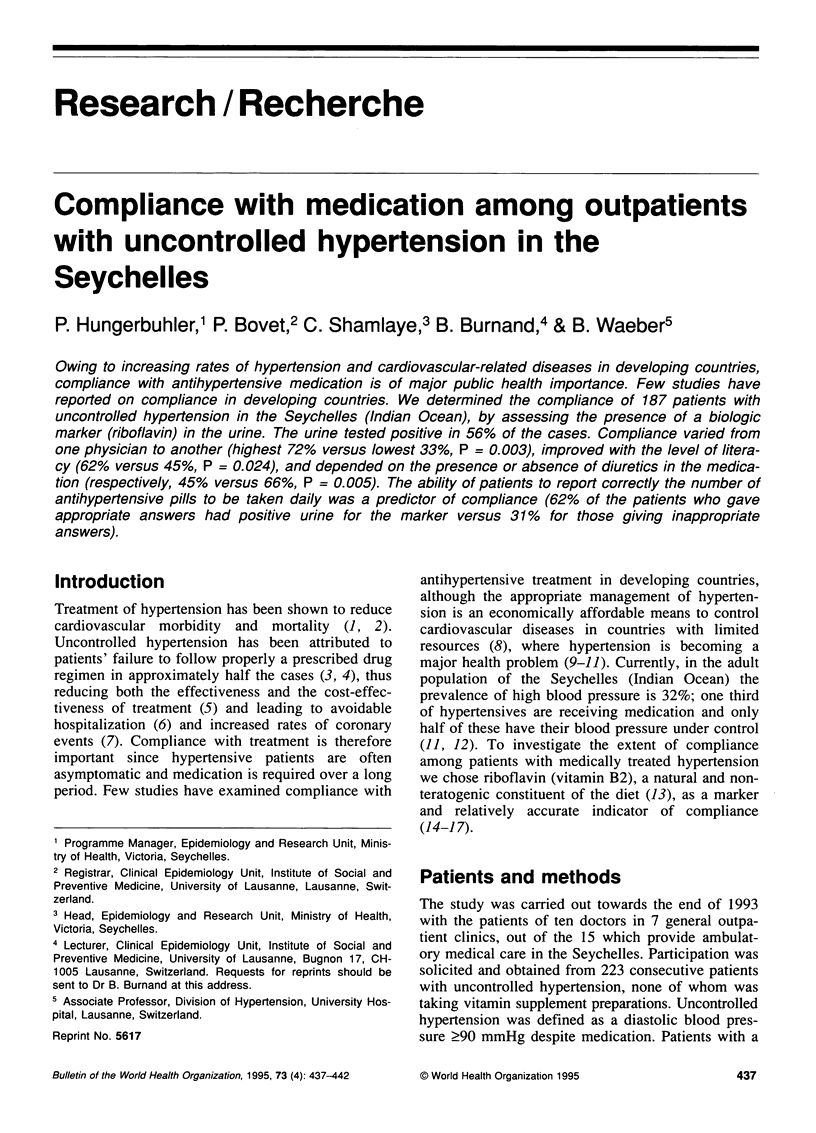
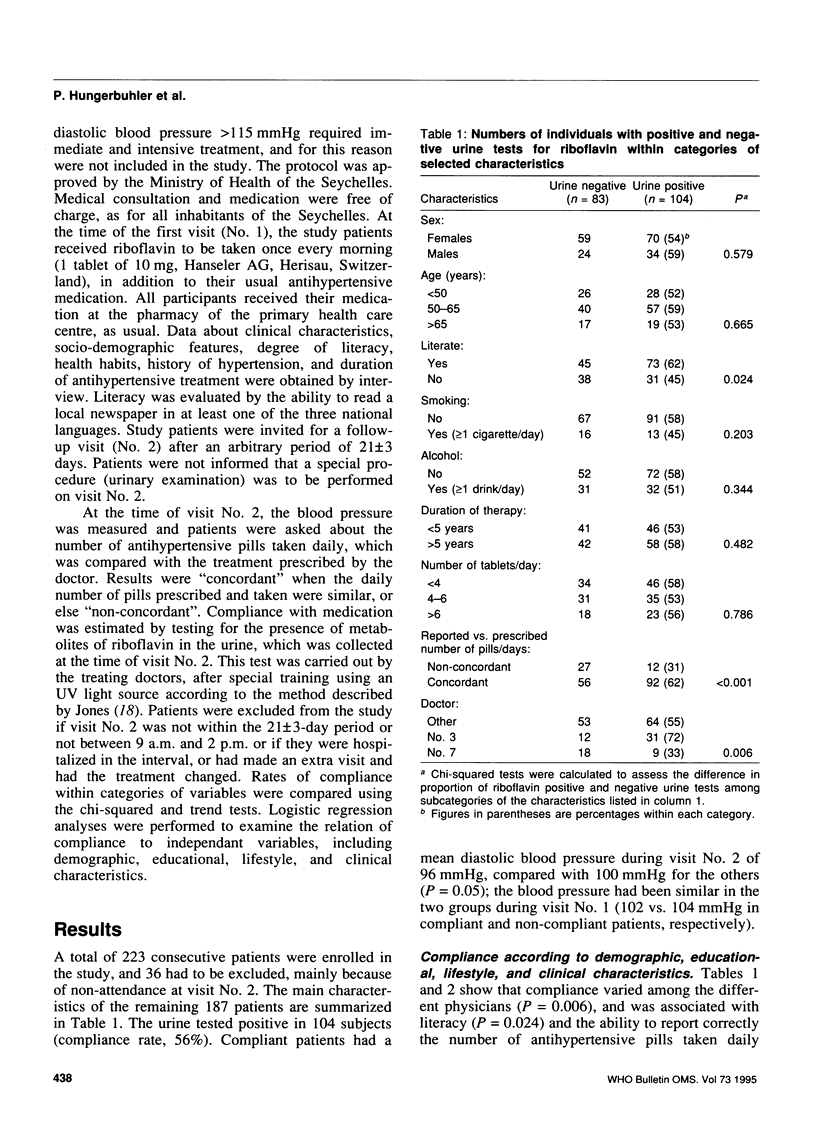
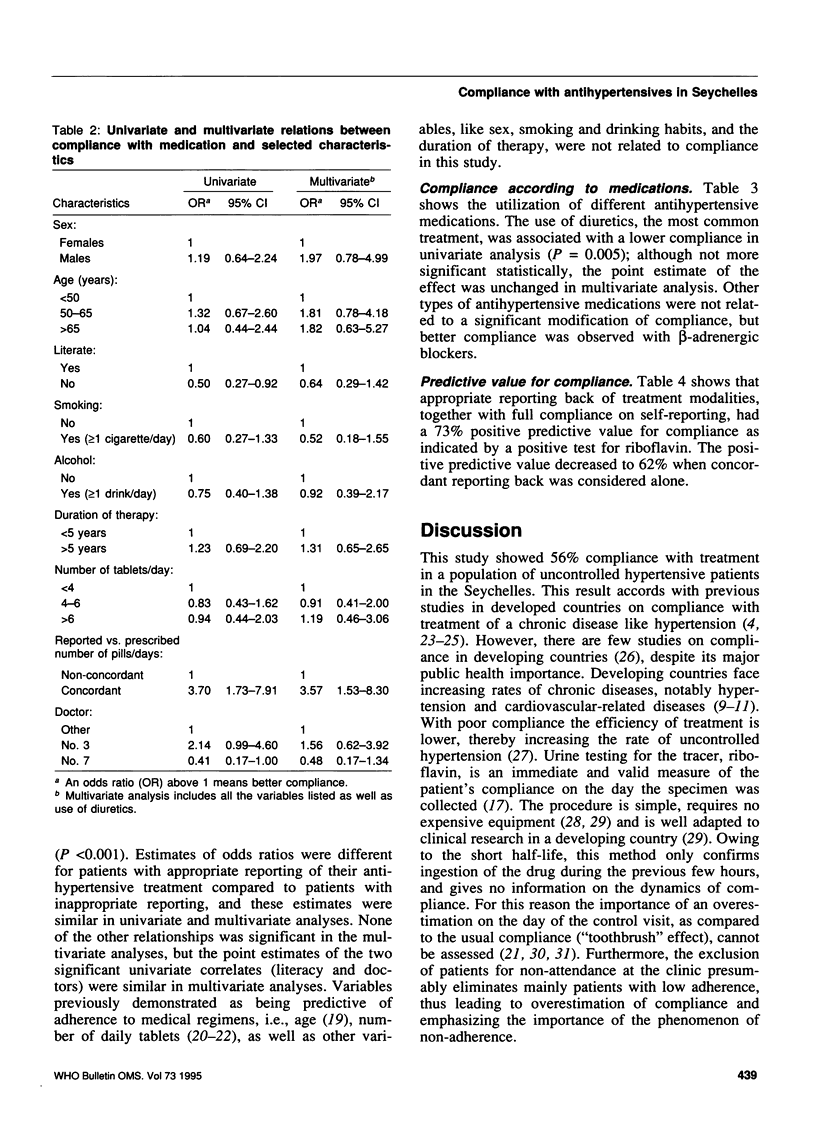
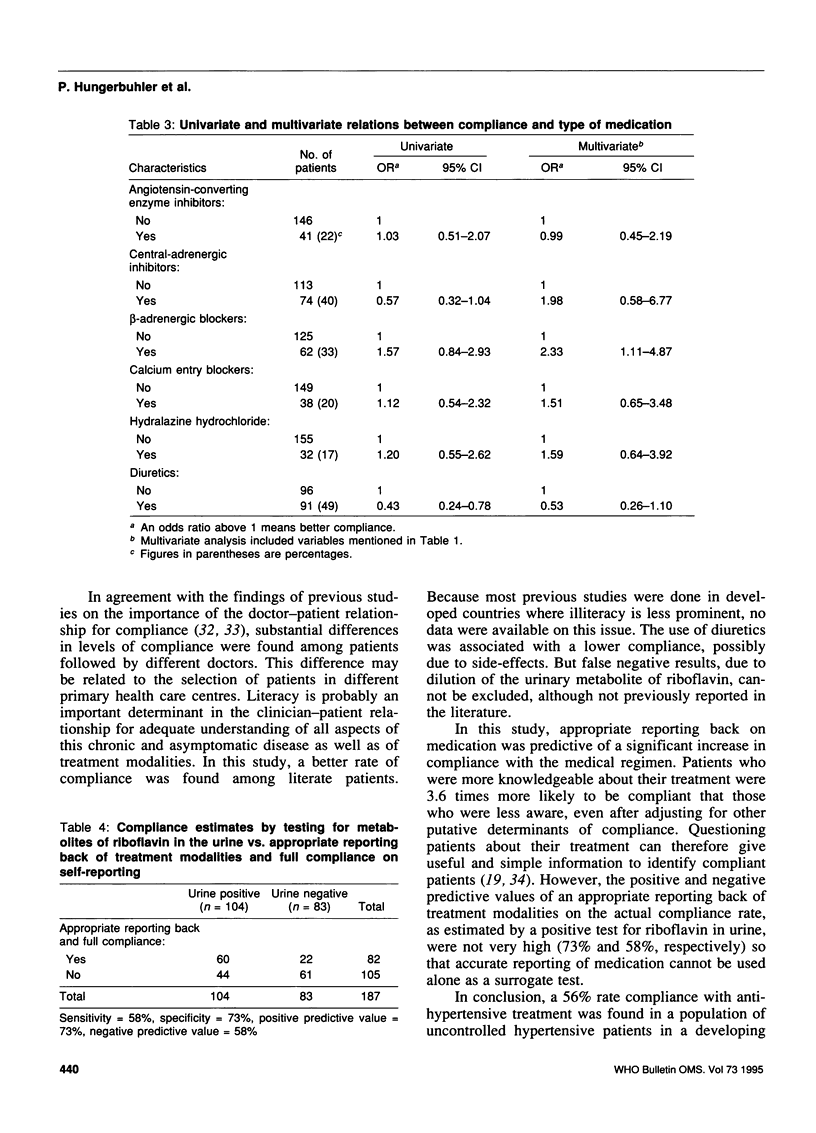
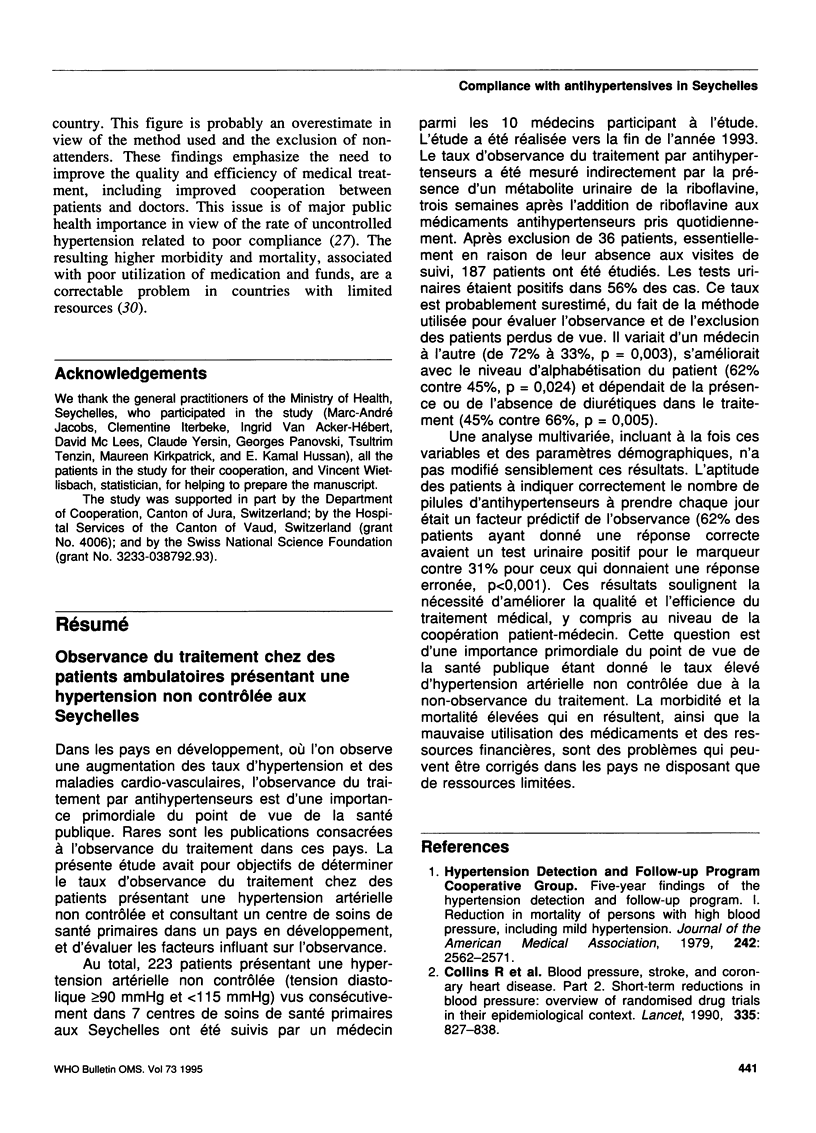
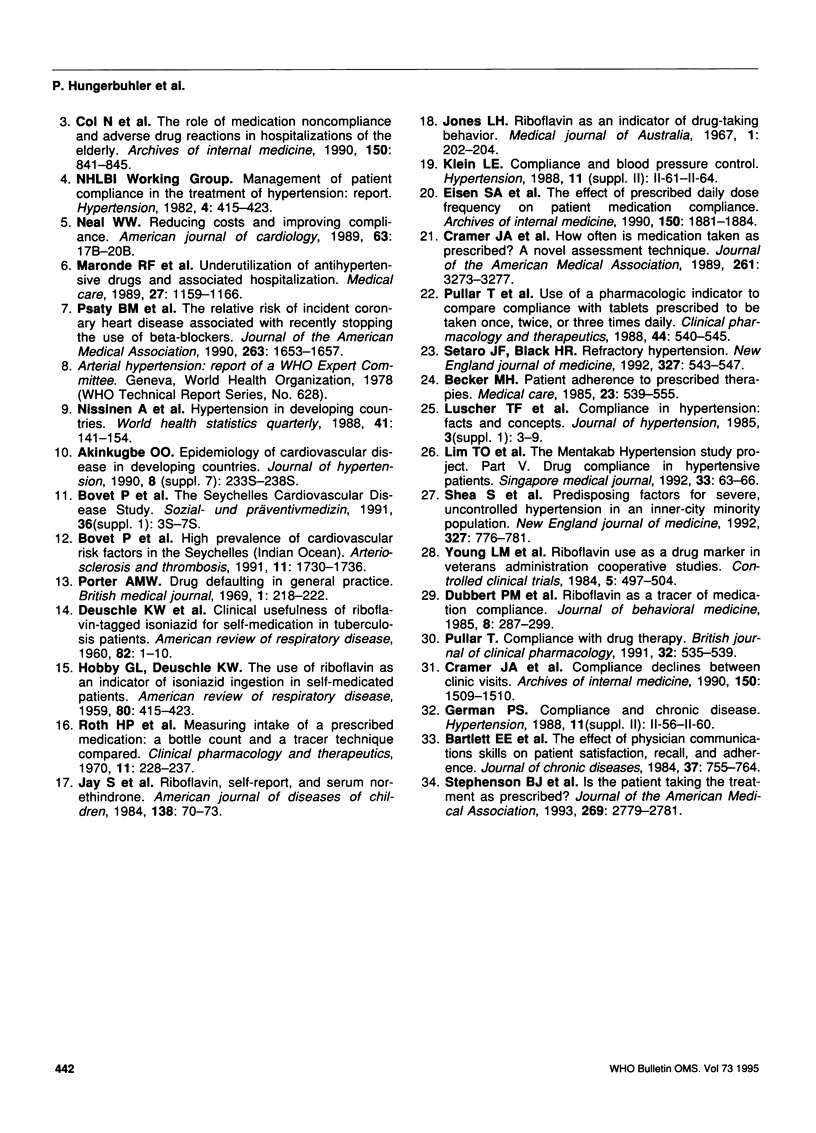
Selected References
These references are in PubMed. This may not be the complete list of references from this article.
- Bartlett E. E., Grayson M., Barker R., Levine D. M., Golden A., Libber S. The effects of physician communications skills on patient satisfaction; recall, and adherence. J Chronic Dis. 1984;37(9-10):755–764. doi: 10.1016/0021-9681(84)90044-4. [DOI] [PubMed] [Google Scholar]
- Becker M. H. Patient adherence to prescribed therapies. Med Care. 1985 May;23(5):539–555. doi: 10.1097/00005650-198505000-00014. [DOI] [PubMed] [Google Scholar]
- Bovet P., Shamlaye C., Kitua A., Riesen W. F., Paccaud F., Darioli R. High prevalence of cardiovascular risk factors in the Seychelles (Indian Ocean). Arterioscler Thromb. 1991 Nov-Dec;11(6):1730–1736. doi: 10.1161/01.atv.11.6.1730. [DOI] [PubMed] [Google Scholar]
- Col N., Fanale J. E., Kronholm P. The role of medication noncompliance and adverse drug reactions in hospitalizations of the elderly. Arch Intern Med. 1990 Apr;150(4):841–845. [PubMed] [Google Scholar]
- Collins R., Peto R., MacMahon S., Hebert P., Fiebach N. H., Eberlein K. A., Godwin J., Qizilbash N., Taylor J. O., Hennekens C. H. Blood pressure, stroke, and coronary heart disease. Part 2, Short-term reductions in blood pressure: overview of randomised drug trials in their epidemiological context. Lancet. 1990 Apr 7;335(8693):827–838. doi: 10.1016/0140-6736(90)90944-z. [DOI] [PubMed] [Google Scholar]
- Cramer J. A., Mattson R. H., Prevey M. L., Scheyer R. D., Ouellette V. L. How often is medication taken as prescribed? A novel assessment technique. JAMA. 1989 Jun 9;261(22):3273–3277. [PubMed] [Google Scholar]
- Cramer J. A., Scheyer R. D., Mattson R. H. Compliance declines between clinic visits. Arch Intern Med. 1990 Jul;150(7):1509–1510. [PubMed] [Google Scholar]
- DEUSCHLE K. W., JORDAHL C., HOBBY G. L. Clinical usefulness of riboflavin-tagged isoniazid for self-medication in tuberculous patients. Am Rev Respir Dis. 1960 Jul;82:1–10. doi: 10.1164/arrd.1960.82.1.1. [DOI] [PubMed] [Google Scholar]
- Eisen S. A., Miller D. K., Woodward R. S., Spitznagel E., Przybeck T. R. The effect of prescribed daily dose frequency on patient medication compliance. Arch Intern Med. 1990 Sep;150(9):1881–1884. [PubMed] [Google Scholar]
- Five-year findings of the hypertension detection and follow-up program. I. Reduction in mortality of persons with high blood pressure, including mild hypertension. Hypertension Detection and Follow-up Program Cooperative Group. JAMA. 1979 Dec 7;242(23):2562–2571. [PubMed] [Google Scholar]
- Jones I. H. Riboflavine as an indicator of drug taking behaviour. Med J Aust. 1967 Feb 4;1(5):202–204. doi: 10.5694/j.1326-5377.1967.tb21152.x. [DOI] [PubMed] [Google Scholar]
- Lim T. O., Ngah B. A., Rahman R. A., Suppiah A., Ismail F., Chako P., Na H. H. The Mentakab hypertension study project. Part V--Drug compliance in hypertensive patients. Singapore Med J. 1992 Feb;33(1):63–66. [PubMed] [Google Scholar]
- Maronde R. F., Chan L. S., Larsen F. J., Strandberg L. R., Laventurier M. F., Sullivan S. R. Underutilization of antihypertensive drugs and associated hospitalization. Med Care. 1989 Dec;27(12):1159–1166. doi: 10.1097/00005650-198912000-00007. [DOI] [PubMed] [Google Scholar]
- Nissinen A., Böthig S., Granroth H., Lopez A. D. Hypertension in developing countries. World Health Stat Q. 1988;41(3-4):141–154. [PubMed] [Google Scholar]
- Porter A. M. Drug defaulting in a general practice. Br Med J. 1969 Jan 25;1(5638):218–222. doi: 10.1136/bmj.1.5638.218. [DOI] [PMC free article] [PubMed] [Google Scholar]
- Pullar T., Birtwell A. J., Wiles P. G., Hay A., Feely M. P. Use of a pharmacologic indicator to compare compliance with tablets prescribed to be taken once, twice, or three times daily. Clin Pharmacol Ther. 1988 Nov;44(5):540–545. doi: 10.1038/clpt.1988.191. [DOI] [PubMed] [Google Scholar]
- Pullar T. Compliance with drug therapy. Br J Clin Pharmacol. 1991 Nov;32(5):535–539. doi: 10.1111/j.1365-2125.1991.tb03948.x. [DOI] [PMC free article] [PubMed] [Google Scholar]
- Roth H. P., Caron H. S., Hsi B. P. Measuring intake of a prescribed medication. A bottle count and a tracer technique compared. Clin Pharmacol Ther. 1970 Mar-Apr;11(2):228–237. doi: 10.1002/cpt1970112228. [DOI] [PubMed] [Google Scholar]
- Setaro J. F., Black H. R. Refractory hypertension. N Engl J Med. 1992 Aug 20;327(8):543–547. doi: 10.1056/NEJM199208203270808. [DOI] [PubMed] [Google Scholar]
- Shea S., Misra D., Ehrlich M. H., Field L., Francis C. K. Predisposing factors for severe, uncontrolled hypertension in an inner-city minority population. N Engl J Med. 1992 Sep 10;327(11):776–781. doi: 10.1056/NEJM199209103271107. [DOI] [PubMed] [Google Scholar]
- Young L. M., Haakenson C. M., Lee K. K., van Eeckhout J. P. Riboflavin use as a drug marker in Veterans Administration cooperative studies. Control Clin Trials. 1984 Dec;5(4 Suppl):497–504. doi: 10.1016/0197-2456(84)90010-2. [DOI] [PubMed] [Google Scholar]


